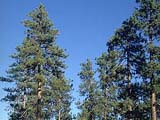|
|
TODAY.AZ / Weird / Interesting
Bacteria on old-growth trees may help forests grow
09 June 2011 [14:50] - TODAY.AZ
 A new study by Dr. Zoë Lindo, a post-doctoral fellow in the Department of Biology at McGill University, and Jonathan Whiteley, a doctoral student in the same department, shows that large, ancient trees may be very important in helping forests grow.
A new study by Dr. Zoë Lindo, a post-doctoral fellow in the Department of Biology at McGill University, and Jonathan Whiteley, a doctoral student in the same department, shows that large, ancient trees may be very important in helping forests grow.These findings highlight the importance of maintaining the large old-growth trees in the coastal temperate rainforests that stretch from Southern Alaska to Northern California. Lindo's findings suggest that it is the interactions between old trees, mosses and cyanobacteria, which contribute to nutrient dynamics in a way that may actually sustain the long-term productivity of these forests.
"What we're doing is putting large old trees into a context where they're an integral part of what a forest is," says Dr. Lindo. "These large old trees are doing something: they're providing habitat for something that provides habitat for something else that's fertilizing the forest. It's like a domino effect; it's indirect but without the first step, without the trees, none of it could happen."
There are three players in this story: 1) large, old trees; 2) mosses that grow along their branches; and 3) a group of bacteria called cyanobacteria associated with the mosses. The cyanobacteria take nitrogen from the atmosphere and make it available to plants-a process called "nitrogen fixation" that very few organisms can do.
The growth and development of many forests is thought to be limited by the availability of nitrogen. Cyanobacteria in mosses on the ground were recently shown to supply nitrogen to the Boreal forest, but until now cyanobacteria have not been studied in coastal forests or in canopies (tree-tops). By collecting mosses on the forest floor and then at 15 and 30 metres up into the forest canopy, Lindo was able to show both that the cyanobacteria are more abundant in mosses high above the ground, and that they "fix" twice as much nitrogen as those associated with mosses on the forest floor.
Moss is the crucial element. The amount of nitrogen coming from the canopy depends on trees having mosses.
"You need trees that are large enough and old enough to start accumulating mosses before you can have the cyanobacteria that are associated with the mosses," Lindo said. "Many trees don't start to accumulate mosses until they're more than 100 years old. So it's really the density of very large old trees that are draped in moss that is important at a forest stand level. We surveyed trees that are estimated as being between 500 and 800 years old."
The research was funded by the Natural Sciences and Engineering Research Council of Canada (NSERC).
/Science Daily/
URL: http://www.today.az/news/interesting/87868.html
 Print version
Print version
Views: 1894
Connect with us. Get latest news and updates.
See Also
- 06 December 2024 [22:20]
Are scented candles harmful to health? - 23 November 2024 [14:11]
Magnitude 4.5 earthquake hits Azerbaijan's Lachin - 20 November 2024 [23:30]
Launch vehicle with prototype of Starship made its sixth test flight - 27 October 2024 [09:00]
Fuel prices expected to rise in Sweden - 24 October 2024 [19:14]
Turkiye strikes terror targets in Iraq and Syria - 23 October 2024 [23:46]
Kazakhstan supplied almost entire volume of oil planned for 2024 to Germany in 9 months - 23 October 2024 [22:17]
Taiwan reported passage of Chinese Navy aircraft carrier near island - 23 October 2024 [21:50]
Russia remains largest oil supplier to India - 16 October 2024 [17:54]
Gamesummit co-founder shares insights on future of gaming industry in Azerbaijan [EXCLUSIVE] - 12 October 2024 [18:27]
TikTok cuts jobs, turns to AI for content moderation
Most Popular
 More Armenians fly: the crisis of power in Canada
More Armenians fly: the crisis of power in Canada
 Azerbaijan, Colombia Discuss Cooperation in Various Fields
Azerbaijan, Colombia Discuss Cooperation in Various Fields
 Azerbaijani delegation participates in internet governance forum in Riyadh
Azerbaijani delegation participates in internet governance forum in Riyadh
 Armenian militant group threatens regional stability aligning with PKK/YPG in new ground
Armenian militant group threatens regional stability aligning with PKK/YPG in new ground
 Rubik Vardanyan surprises his own lawyers
Rubik Vardanyan surprises his own lawyers
 Azerbaijan's role in COP29 highlights growing global influence, says MEDIA Director
Azerbaijan's role in COP29 highlights growing global influence, says MEDIA Director
 Lapshin shows up, again collecting alms from naive Armenians
Lapshin shows up, again collecting alms from naive Armenians
